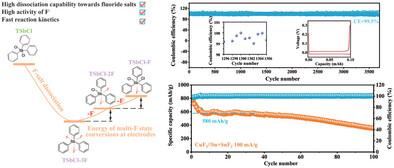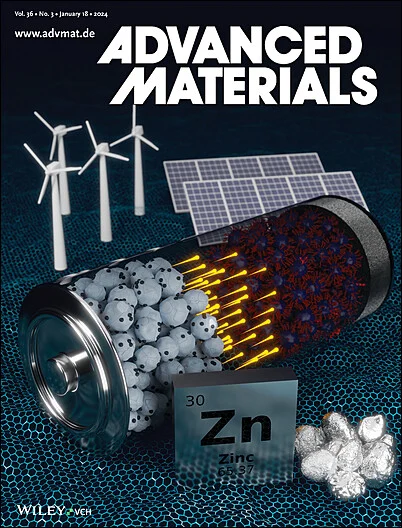Construction of Acceptor-Multi-F State Electrolyte to Enable Unprecedented Long-Life and High-Capacity Fluoride-Ion Batteries
IF 27.4
1区 材料科学
Q1 CHEMISTRY, MULTIDISCIPLINARY
引用次数: 0
Abstract
Fluoride ion batteries (FIBs) have garnered significant attention due to their ultrahigh theoretical energy density, dendrite-free safety, and resource abundance. Although some anion acceptors have been proposed to address the insolubility of inorganic fluoride salts, the difficulty in dissociating fluoride ions from acceptors results in short lifespan and extremely low specific capacity of FIBs. Here, a fluoride ion battery is demonstrated with unprecedented long life and ultrahigh specific capacity through the design of an acceptor-multi-F state electrolyte. The high Lewis acidity of triphenylantimony chloride (TSbCl) as a novel anion acceptor in electrolyte facilitates the complete dissociation of CsF, and the resulting TSbCl-F complex can further interact with fluoride ions to form the acceptor-multi-F states. This strategy combines the high dissociation capability for fluoride salts with the minimal thermodynamic barriers for releasing fluoride ions at electrode-electrolyte interface. This electrolyte design endows FIBs with durable reversible fluorination/defluorination reaction (3700 cycles with high coulombic efficiency of 99.5% and small voltage polarization of 30 mV) and ultrahigh reversible capacity (580 mAh g−1 after 40 cycles at 100 mA g−1). The high-output voltage FIBs of CuF2//Li configuration (with discharge plateau of 2.9 V) and larger-sized pouch-type FIBs of CuF2//Sn+SnF2 configuration (with reversible capacity of 530 mAh g−1) are demonstrated.

求助全文
约1分钟内获得全文
求助全文
来源期刊

Advanced Materials
工程技术-材料科学:综合
CiteScore
43.00
自引率
4.10%
发文量
2182
审稿时长
2 months
期刊介绍:
Advanced Materials, one of the world's most prestigious journals and the foundation of the Advanced portfolio, is the home of choice for best-in-class materials science for more than 30 years. Following this fast-growing and interdisciplinary field, we are considering and publishing the most important discoveries on any and all materials from materials scientists, chemists, physicists, engineers as well as health and life scientists and bringing you the latest results and trends in modern materials-related research every week.
 求助内容:
求助内容: 应助结果提醒方式:
应助结果提醒方式:


